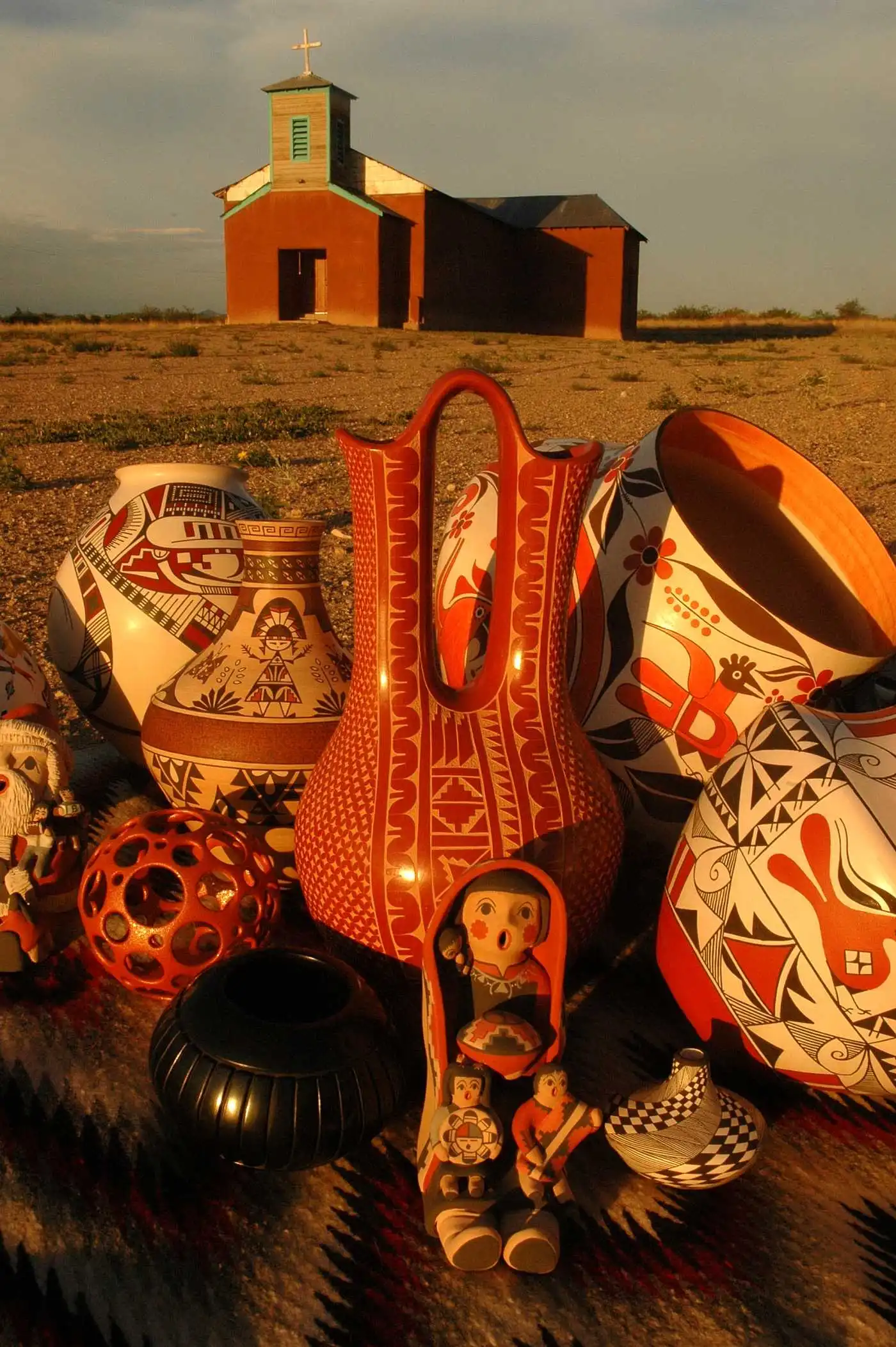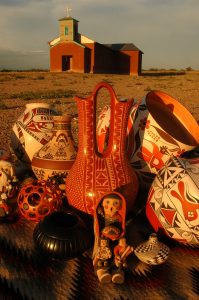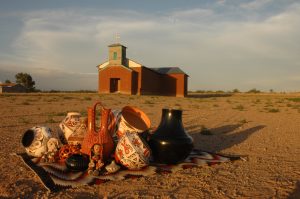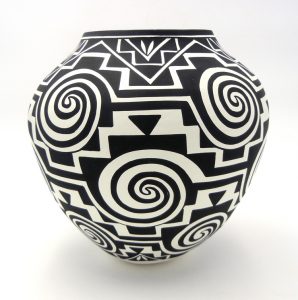**Taken from Palms Trading Company Owner Guy Berger’s book, Pueblo and Navajo Contemporary Pottery and Directory of Artists, Second Edition**
Almost every day as we buy Pueblo pottery here at Palms Trading Company, I get asked the question, “How do you determine the value of each piece?” Well, the answer isn’t quite as simple as many people may think. It really takes many years of dealing with each artist and realizing that all artists have their own unique styles which determine the value of each piece.
I think the most obvious ways to determine the value of pottery are considering the size of a pot and whether a pot is made by the traditional method of coiling or by the molded ceramic type. Other determining factors are the quality and intricacy of a design. Those, being the most obvious ways to determine value, are only some of the factors needed to make a good judgment as to each piece’s worth.
There are also many subtle factors, such as the accomplishment of the artist (i.e. awards won, citations received and the general demand for their work), the pueblo that they are from, and the envisioned potential each artist may have in the future that also play a part in my decision as to the value of each piece.
In addition to all of these factors, each pueblo’s pottery can be judged by a different standard. For instance, Acoma pottery is judged by shape, thinness of the walls, and intricacy of the design. On the other hand, Santa Clara pottery is not only judged by shape and design, but more importantly, quality of the polish.
In order to do a complete job explaining how to buy a piece of pueblo pottery, I think it would be best to segment each pueblo and give a short description of how I determine the value of a pot from that particular pueblo. You must always remember that what pleases your eye is the most important factor. You can have all of the history, family lineage and fame of a particular potter and still not like the work, which means you probably won’t be happy with it when you get it home.
In dealing with traditional coiled Acoma pottery, the first thing I do is tap the pot with either my finger, or a pen. If it rings like a bell, the pottery is sound. If when I tap it the sound is a THUD, it usually has a hairline crack somewhere around the rim. The second thing I’ll do is look at the shape. Even though the pot is hand-coiled, the shape should be as close to symmetrical and round as possible. I do these things first because no matter how good the design is or how large the pot is, if it’s cracked or crooked, the pot has much less value. Now, if the pot rings like a bell and the shape is pleasant to the eye, I will look at the quality and intricacy of the design and factor in the size of the piece. Then, with those factors under consideration, I will determine how well known a particular artist is, how much demand we’ve seen for that artist, and whatever future potential I can see in that artist. After all of this, I determine and offer a price. In most cases, the artist and I are no more than 10 percent apart on a price. I give a little, they give a little, and we come up with a mutually beneficial price. This rule of thumb will hold true in each of the other pueblos I discuss. As far as ceramic, molded 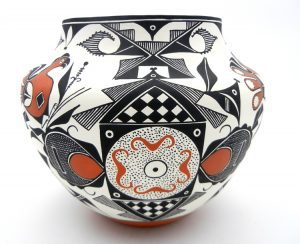 Acoma pottery goes, there are not as many determining factors. Of course the most common thing I do is check for cracks. The shapes of ceramic pots MUST always be symmetrical. The final determination is quality of design. It must be noted here that there are some excellent pueblo artists that do not make their own pottery, but are quite accomplished in the intricate designs they produce. Greenware pots are not as collectible as traditional pots, but serve the purpose of decoration and design just as traditional handmade pots do.
Acoma pottery goes, there are not as many determining factors. Of course the most common thing I do is check for cracks. The shapes of ceramic pots MUST always be symmetrical. The final determination is quality of design. It must be noted here that there are some excellent pueblo artists that do not make their own pottery, but are quite accomplished in the intricate designs they produce. Greenware pots are not as collectible as traditional pots, but serve the purpose of decoration and design just as traditional handmade pots do.
Santa Clara
When I buy Santa Clara pottery, many of the same principles apply as they do in buying Acoma pots. I do not usually tape Santa Clara pots to listen for rings, because they will not ring like a bell. However, each pot must be inspected  for fractures in the rim, or along the sides, and of course I look at the shape quite closely. A specific flaw that must be viewed with Santa Clara pottery, or San Ildefonso for that matter, are small “blisters” that show on the polished surface as bubbles. The cause of this is probably moisture between the actual clay and the polished surface. There is nothing between the polish and the clay but air in these “blisters,” and they will eventually crack and fall away with any type of pressure at all. I try to avoid buying pots with “blisters,” as the value drops significantly when these occur.
for fractures in the rim, or along the sides, and of course I look at the shape quite closely. A specific flaw that must be viewed with Santa Clara pottery, or San Ildefonso for that matter, are small “blisters” that show on the polished surface as bubbles. The cause of this is probably moisture between the actual clay and the polished surface. There is nothing between the polish and the clay but air in these “blisters,” and they will eventually crack and fall away with any type of pressure at all. I try to avoid buying pots with “blisters,” as the value drops significantly when these occur.
With matte on black designs, (i.e. liquid clay mixture painted over a polished surface), which are not nearly as intricate as other pueblo designs, the key element in determining value is the quality of the polish. High quality Santa Clara pottery has polish with very little variation on the surface. You should see small amounts of streaking or deviation in the black color on the surface of the pot. This 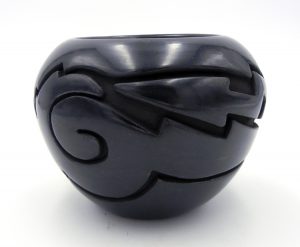 even becomes more critical when buying red Santa Clara pottery, because it takes a special touch and much talent and experience to achieve a high quality polish in the red finish. It is not as difficult to achieve this high quality in the black polish because, when pots are fired black, many of the variations in shade are evened out by the black firing. These elements, in addition to, of course, the reputation of the artist and family name, are the most important keys in determining value. There are no greenware Santa Clara pots.
even becomes more critical when buying red Santa Clara pottery, because it takes a special touch and much talent and experience to achieve a high quality polish in the red finish. It is not as difficult to achieve this high quality in the black polish because, when pots are fired black, many of the variations in shade are evened out by the black firing. These elements, in addition to, of course, the reputation of the artist and family name, are the most important keys in determining value. There are no greenware Santa Clara pots.
Jemez
Jemez pottery has come a long way in the past thirty years. From the 1950’s, when bright colored poster paints 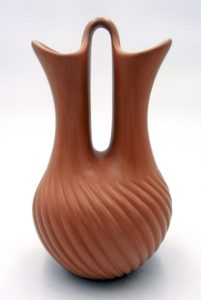 were the norm, we now see very high quality Jemez pottery with stone polished finishes that rival the best of any other pueblo. I think the Jemez pueblo potters have the largest gap between lower end pieces and high quality collector’s items. In the lower end Jemez pieces, the artists are so prolific that the determining factors of price come down to size and shape. These Jemez pots are not particularly thin-walled, and have very simple designs. Sometimes we buy
were the norm, we now see very high quality Jemez pottery with stone polished finishes that rival the best of any other pueblo. I think the Jemez pueblo potters have the largest gap between lower end pieces and high quality collector’s items. In the lower end Jemez pieces, the artists are so prolific that the determining factors of price come down to size and shape. These Jemez pots are not particularly thin-walled, and have very simple designs. Sometimes we buy 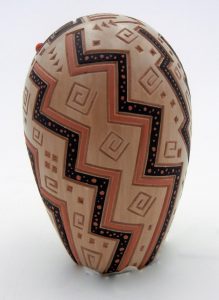 as many as fifty to one hundred of the same size and shape at a time. This enables me to keep the prices much lower on these items than with any other pueblo. On the other hand, the more accomplished Jemez artists are doing very unique work. A lot of Jemez artists have mastered the art of sgraffito, which are etched designs on polished pottery. These include floral designs, animals, insects and landscape. Determining prices on these pots would rival the determinations on Santa Clara pottery. First, of course, I look for shape with no cracks, and then determine intricacy of design, reputation of the artist and size of the piece. Very little ceramic pottery from Jemez is produced. However, when these are made, price should be determined solely on size, shape and design.
as many as fifty to one hundred of the same size and shape at a time. This enables me to keep the prices much lower on these items than with any other pueblo. On the other hand, the more accomplished Jemez artists are doing very unique work. A lot of Jemez artists have mastered the art of sgraffito, which are etched designs on polished pottery. These include floral designs, animals, insects and landscape. Determining prices on these pots would rival the determinations on Santa Clara pottery. First, of course, I look for shape with no cracks, and then determine intricacy of design, reputation of the artist and size of the piece. Very little ceramic pottery from Jemez is produced. However, when these are made, price should be determined solely on size, shape and design.
We hope this short lesson on determining the value of pottery in these three pueblos as been helpful and informative. If you have any further questions, please visit or call us and we will be happy to add further information based on our long experience and relationships with the potters from each of these, and other pueblos. We are proud to continue to offer Authentic Native American Art You Can Trust.



